On December 5th, Xiaomi Group officially unveiled its inaugural "Xiaomi Group Climate Action White Paper" through its official social media account. The white paper outlines Xiaomi's methodology for achieving zero-carbon transformation, disclosing the carbon emission data for the entire value chain over the past three years and presenting a roadmap to achieve net-zero emissions.
Prior to this, Xiaomi Group had repeatedly expressed its commitment to achieving carbon neutrality. On October 30th, Xiaomi Group's founder, Lei Jun, stated, "Xiaomi Group officially commits to carbon neutrality by 2040, using 100% renewable energy." It's important to note that Xiaomi Group's carbon neutrality commitment pertains to achieving carbon neutrality within Scopes 1 and 2, excluding Scope 3.
This article delves into Xiaomi Group's ESG reports and the Climate Action White Paper to provide an in-depth analysis of the progress and achievements on Xiaomi's path to carbon neutrality. It particularly focuses on Xiaomi's exploration and initiatives in carbon accounting, carbon emission reduction, and establishing a low-carbon supply chain.
01 Xiaomi Group's Climate Action
Xiaomi Group chose to officially release its inaugural Climate Action Report during the 28th Conference of the Parties to the United Nations Framework Convention on Climate Change (COP28). This strategic timing underscores Xiaomi's commitment to addressing climate change and aligns with the company's steadfast determination towards carbon neutrality. What are the key highlights of Xiaomi Group's Climate Action Report?
Key Point 1: The "Three-Stage Rocket" Response to Low-Carbon Transformation and the Key Industries and Roadmap for Zero-Carbon Transformation

"Three-stage rocket" and key industries and roadmap for zero-carbon transformation
Key Point 2: Accounting for the carbon footprint of the entire product lifecycle.
In 2022, Xiaomi Group initiated the Product Carbon Footprint Accounting Project, completing the carbon footprint assessment for the entire lifecycle of 2 smartphones, 2 smart air conditioners, and 1 wearable product.
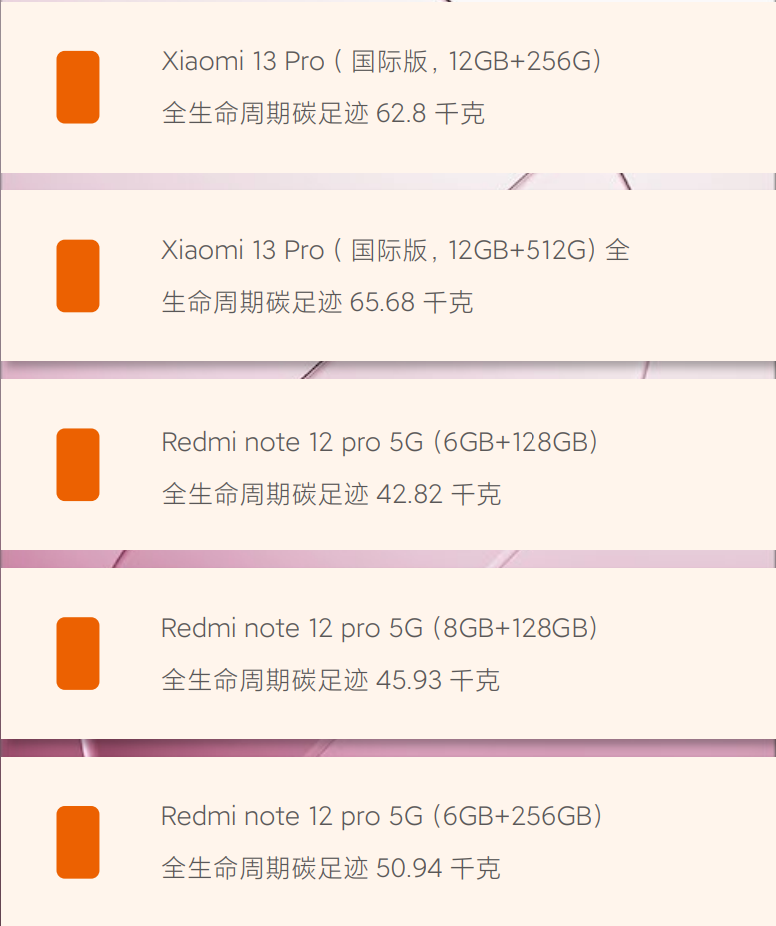
The entire lifecycle carbon footprint of Xiaomi Group's smartphones
Simultaneously, Xiaomi Group collaborated with independent greenhouse gas emission accounting and certification organizations, establishing a comprehensive assessment process and methodological model for the carbon footprint of smartphone products. This calculation method adheres to the requirements of the PAS 2050 international standard for carbon footprint calculation.
In the future, Xiaomi Group plans to gradually establish a carbon footprint accounting and management system covering multiple product categories, including smartphones, air conditioners, smart TVs, and other ecosystem products.
Supplier carbon footprint audits are crucial for Xiaomi's comprehensive value chain carbon footprint assessment. To successfully conduct a carbon footprint audit and calculation across the industrial chain, Xiaomi Group and upstream/downstream industry chain enterprises need to collaborate, collectively creating a digital management system aligned with carbon footprint requirements.
Xiaomi Group stated in its ESG report that the gradual implementation of a digitalized supply chain management system will contribute to achieving Xiaomi's goal of fully digitizing the supply chain lifecycle.
Key Point 3: Scrutinizing the greenhouse gas emissions throughout the entire value chain.
Xiaomi Group adheres to the "Greenhouse Gas Protocol: A Corporate Accounting and Reporting Standard," "ISO 14064-1:2018 Specification with Guidance at the Organization Level for Quantification and Reporting of Greenhouse Gas Emissions and Removals," and relevant national, local, and industry standards. The company has established carbon data standards and models that comply with local regulations at operational sites. Over the past three years, specific data for greenhouse gas emissions in Scope 1, 2, and 3 are as follows:
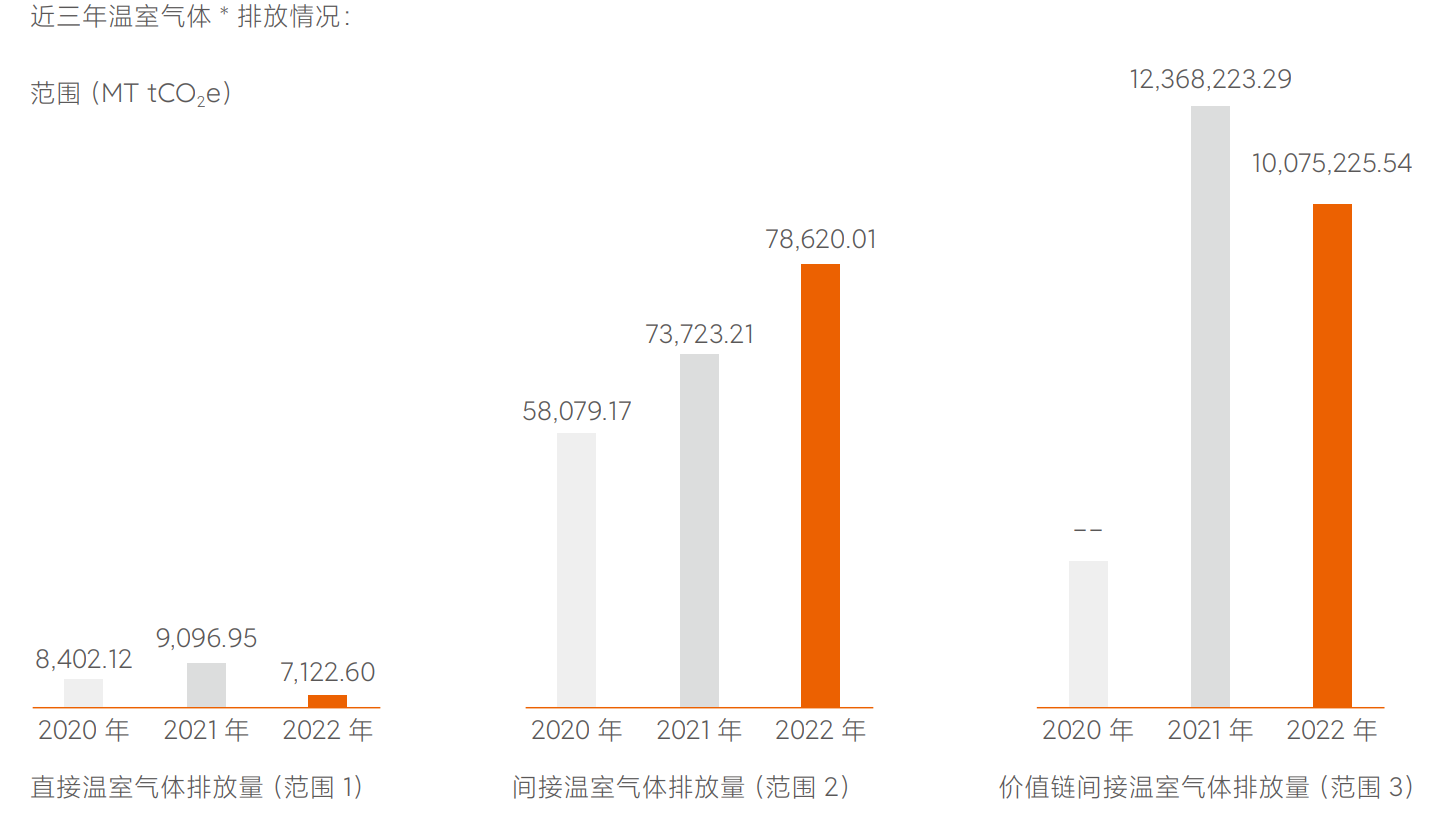
Greenhouse gas emissions data for Scope 1, 2, and 3
From 2020 to 2022, the emissions for Scope 1 were 8,402 MT tCO2e, 9,096 MT tCO2e, and 7,122 MT tCO2e, respectively. For Scope 2, the emissions were 58,079 MT tCO2e, 73,723 MT tCO2e, and 78,620 MT tCO2e in the same years. In the period from 2021 to 2022, the emissions for Scope 3 were 12,368,223 MT tCO2e and 10,075,225 MT tCO2e.
We observed that in 2022, Xiaomi Group's Scope 3 emissions accounted for 99.16% of the total emissions, highlighting that reducing Scope 3 emissions is crucial for the company to achieve its carbon neutrality goal across the entire value chain.
Given that Scope 3 carbon emissions involve a wide range and the data foundation is relatively thin, defining emission boundaries becomes challenging, making it difficult for most companies to systematically quantify emissions and drive reduction efforts. This underscores the need for more digital innovation technologies that contribute to emissions reduction. Companies can leverage third-party digital service providers to explore technological solutions.
By employing digital technologies, businesses can establish data communication mechanisms throughout the entire supply chain, facilitating the comprehensive tracking of carbon emissions information across various stages and segments. This enables the assessment and tracking of decarbonization efforts by suppliers, allowing intelligent optimization of procurement strategies and implementation of supply chain emission reduction measures.
Key Point Four: Achieving Net Zero Pathway and Critical Phases
Xiaomi Group has unveiled the net-zero roadmap in the "Xiaomi Group Climate Action White Paper": By implementing energy efficiency improvement technologies, electrification, and widespread application of intelligent management systems, it aims to minimize carbon footprint by maximizing energy efficiency in both operations and the product lifecycle. It plans to achieve the green transformation of the energy structure through methods such as long-term power purchase agreements.
Here are the five paths to achieve the net-zero goal:
1. Continuous Improvement in Material Efficiency: Streamline product features and designs, extend product lifespan, improve manufacturing processes and organizational efficiency, and enhance the overall lifecycle efficiency of unit raw material consumption.
2. Continuous Enhancement of Energy Efficiency: Utilize new technologies, materials, and intelligent technologies, optimize system energy efficiency, and improve the overall lifecycle efficiency of unit energy consumption.
3. Continuous Expansion of Green Electricity Integration: Improve the flexibility and interactivity of terminal power systems, enhance the usability of green electricity, and increase the energy consumption share of green electricity in the value chain and user usage processes.
4. Continuous Increase in Green Materials: Cultivate new material technologies, innovate in product selection and practice circular economy principles, and increase the proportion of sustainable materials in material consumption.
5. Continuous Promotion of Net-Zero Circularity: Establish a circular system for comprehensive material utilization in the industrial process and the recycling and regeneration of products after retirement, continuously reducing the overall lifecycle solid waste volume.
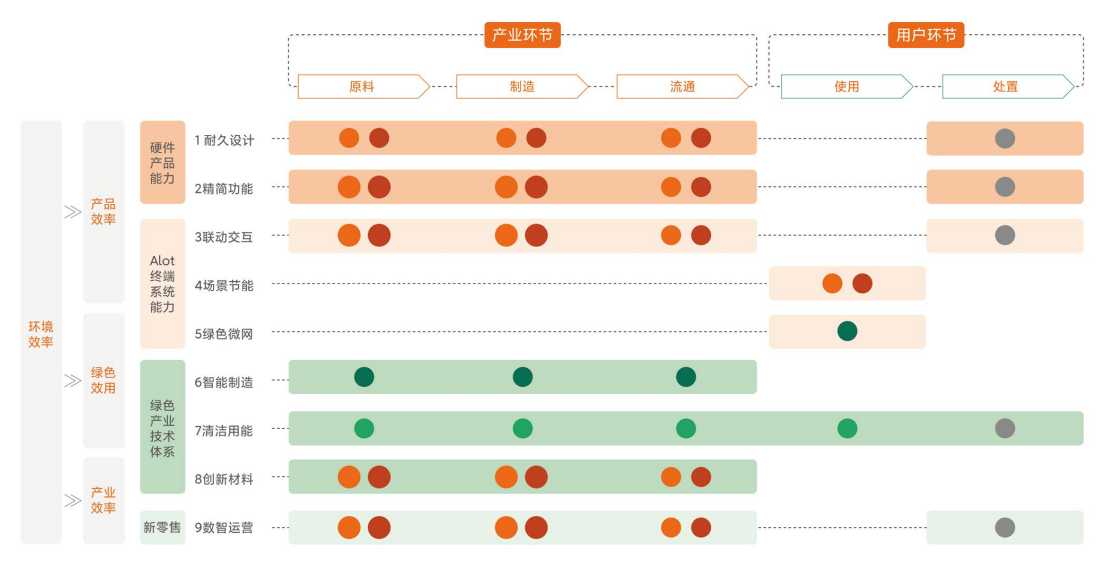
Xiaomi Zero Carbon Approach
The focus on key aspects includes:
1. Raw Materials Stage: Deep collaboration with upstream suppliers in the industrial chain, striving to achieve 100% of key materials such as metal and plastic from low-carbon footprint renewable sources. Simultaneously, accelerate research and application of next-generation low-carbon materials to ensure the environmental friendliness and sustainability of raw material procurement.
2. Production Stage: Continuous efforts to improve production efficiency, aiming to use green energy for the entire manufacturing stage. Also, guide and support core suppliers in transitioning to net-zero emissions. Through efficient energy management and the substitution of clean energy, minimize the carbon footprint in the production process.
3. Product Use Stage: Through technological innovation, enhance the energy efficiency of smartphones and other electronic products. Achieve improved performance while reducing energy consumption. Strive to ensure that 100% of the sold electronic devices can be powered by green energy, providing end-users with choices and convenience for clean energy usage.
4. Packaging: Comprehensive transition to the use of recyclable, biodegradable green packaging materials. Simultaneously, Xiaomi will spare no effort to reduce unnecessary packaging, achieving the maximum simplification of packaging and minimizing environmental impact.
02 Xiaomi Group Carbon Management
Carbon footprint inventory
Employee Carbon Account Audit
Carbon accounts, as the fundamental carriers for recording corporate carbon assets, can be used in various processes such as holding, fulfilling, settling, trading, or managing, and are crucial tools for empowering efficient carbon management in enterprises. Leveraging its own data, technology, and platform advantages, Xiaomi Group has established an internal employee carbon account system to record and manage the carbon emissions of each employee.
Every Xiaomi Group employee possesses an independent carbon account, containing individual carbon emission data, carbon reduction measures, carbon-neutral actions, and other related information. Through this system, employees can gain a clear understanding of their carbon footprint and actively participate in carbon reduction and offset activities. Within the entire system, Xiaomi Group will implement a carbon reduction incentive mechanism to encourage employees to engage in carbon reduction actions such as eco-friendly commuting and travel. It is evident that Xiaomi aims to foster a corporate culture that actively participates in carbon neutrality through the carbon account system.
Supplier Carbon Audit
In 2022, Xiaomi conducted carbon audits for key and strategic product suppliers, referencing ISO 14064 and the Greenhouse Gas Protocol (GHG Protocol) to establish standards for supplier emission accounting. This resulted in the formation of Xiaomi's supplier carbon emission accounting standard system.
Taking the example of Xiaomi Group's smartphone supply chain, 118 suppliers have set carbon reduction targets, with 9 new suppliers joining the Science Based Targets initiative (SBTi). Sixty-four suppliers have completed or are undergoing third-party greenhouse gas emission data verification, and 50 suppliers are utilizing renewable energy sources such as solar, wind, and hydropower. This demonstrates Xiaomi Group's active efforts to promote the low-carbon transformation of its suppliers.
Leading tech companies, such as Huawei, also integrated carbon reduction requirements into their entire supplier management process in 2021, urging all suppliers to achieve carbon neutrality ahead of schedule.
Therefore, suppliers should promptly conduct carbon data calculation and disclosure, actively explore the potential for emissions reduction in the supply chain, and meet the brand's demand for a green and low-carbon supply chain.
Sustainable Management Strategy and Governance Structure
Xiaomi Group has fully integrated ESG (Environmental, Social, and Governance) management into its business operations and management, considering it as one of the company's development strategies. The sustainable development governance structure established by Xiaomi Group consists of the strategic layer, coordination layer, and execution layer. The Board of Directors, through work reports, receives updates on the progress of relevant ESG initiatives and supervises the implementation of ESG measures. The top management is responsible and empowered to ensure the implementation of ESG strategy and investments align with the overall objectives.
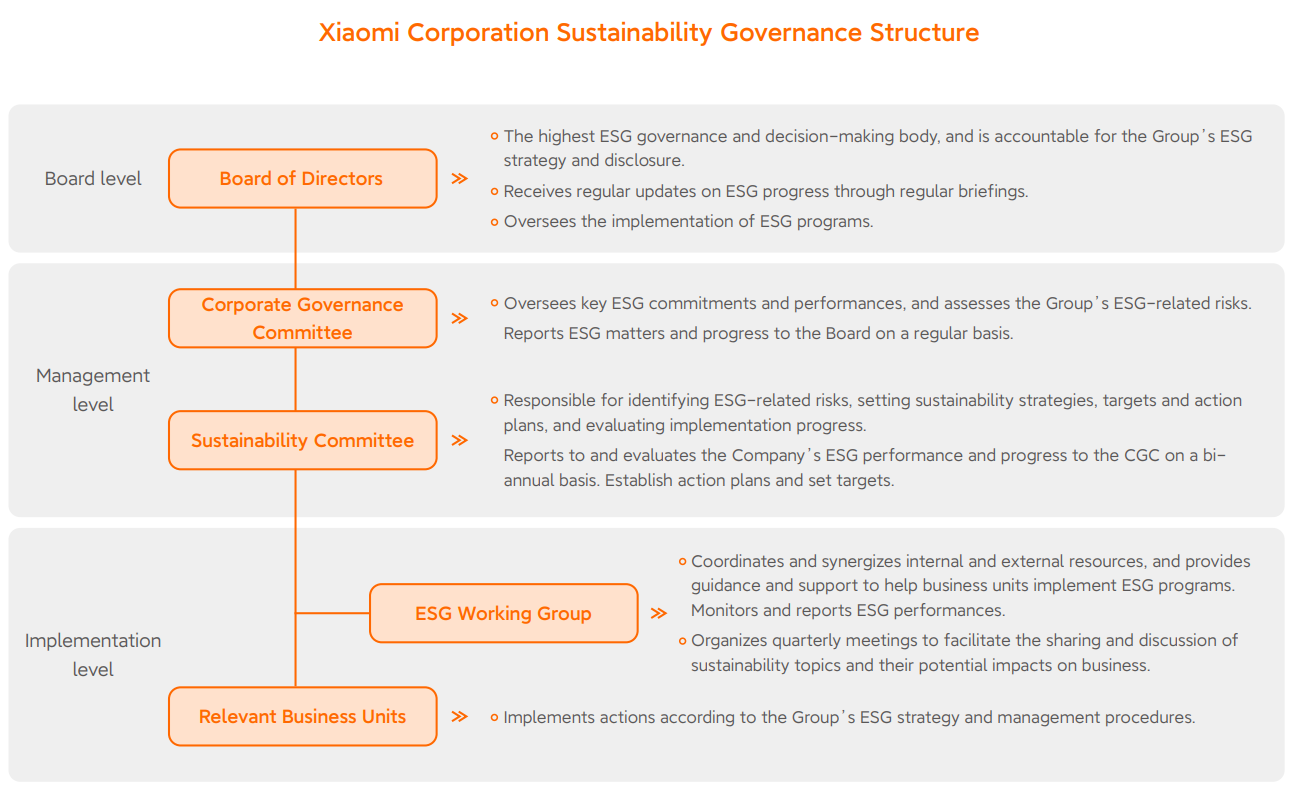
The Group's President, along with other senior executives, leads the Sustainable Development Committee. This committee is composed of managers responsible for ESG-related matters and is dedicated to identifying ESG-related risks, formulating strategies, goals, and plans related to sustainable development, and reviewing the implementation results.
At the execution level, the ESG Working Group is responsible for coordinating internal and external resources, providing guidance, and supporting the relevant departments in implementing action plans, and reporting on performance.
03 The Confidence Behind Xiaomi Group's Carbon Neutrality Journey
Low-Carbon Supply Chain Ecosystem
"To understand Xiaomi Group's industrial ecosystem, one must first explore the investment landscape of the Xiaomi ecosystem. Noticeable in this landscape are prominent investors such as Xiaomi Wuhan, Tianjin Jinmi Entrepreneurship, and Tianjin Jinmi, all of which are investment entities in Xiaomi Group's supply chain companies.
It can be said that one of the key focuses of Xiaomi's investments is incubating supply chain companies for Xiaomi Group. Through investment empowerment and product synergy, Xiaomi and its ecosystem companies have formed a powerful 'alliance'.
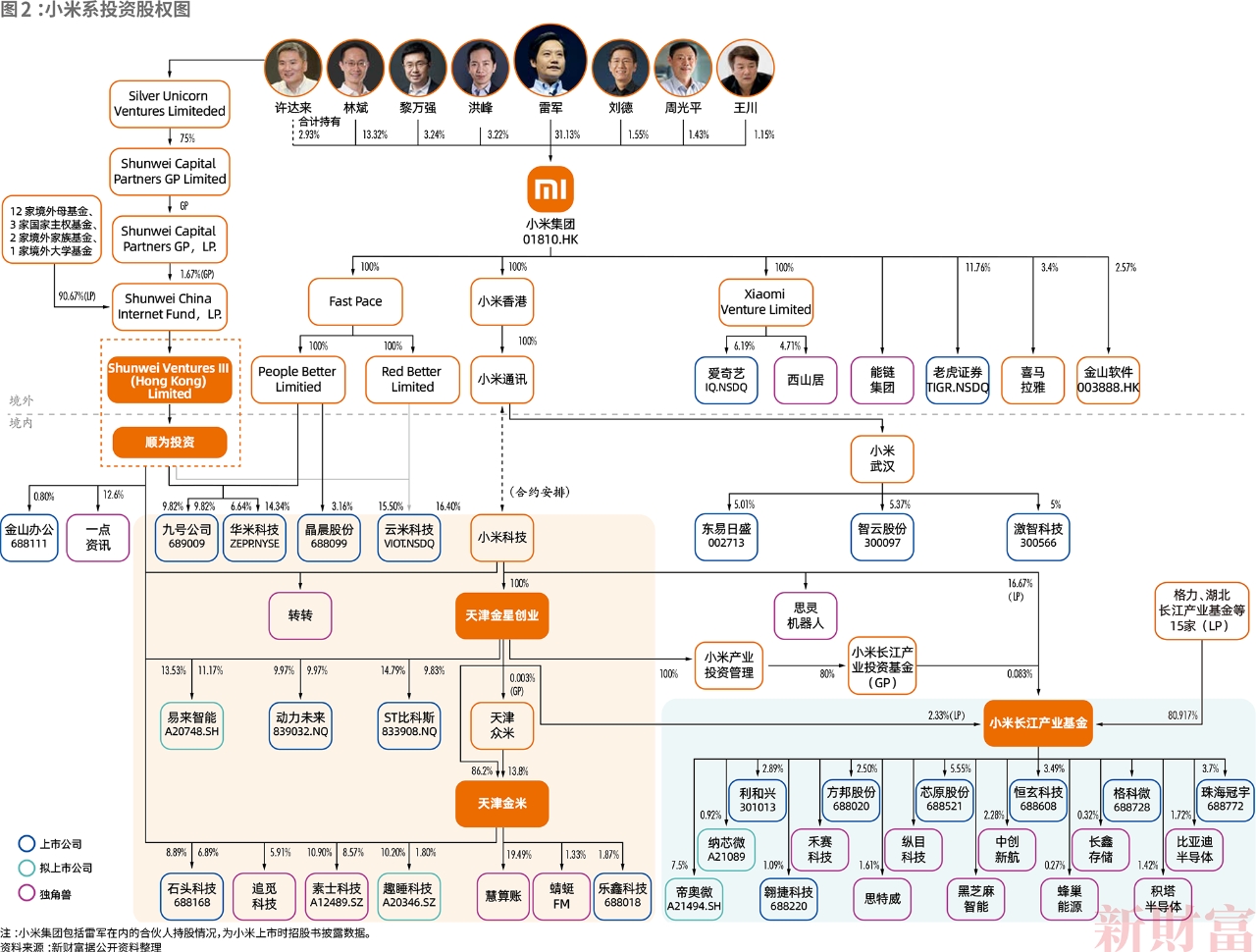
Compiled by New Fortune, Data Source: Xiaomi Group's Prospectus and Financial Reports, etc.
From a product perspective, the entire Xiaomi ecosystem is centered around smartphones, with concentric layers consisting of smartphone accessories, smart peripherals, and daily consumables. Behind the dozens of product categories connected by the ecosystem are hundreds of supply chain companies, collectively building Xiaomi's supply chain ecosystem.
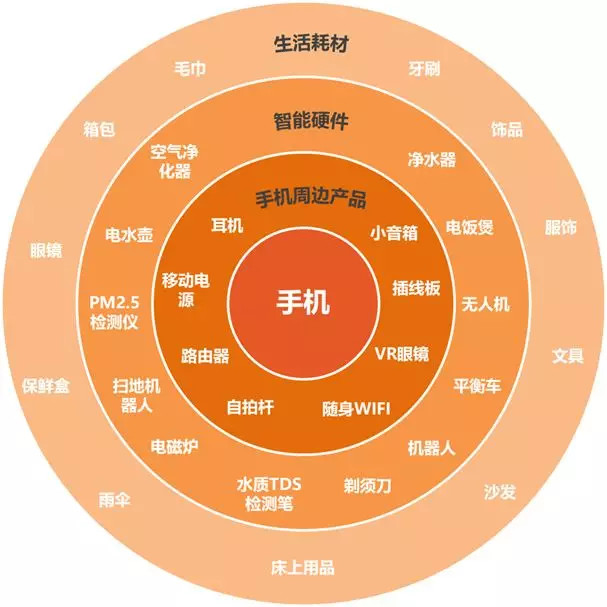
Xiaomi Group's Ecological Chain Investment Circle
Establishing an ecosystem not only involves sharing benefits but, amid the dual carbon waves, also requires jointly shouldering the responsibility of low-carbon transformation. As of the end of 2022, Xiaomi Group had a staggering 1025 suppliers related to hardware manufacturing within its supply chain. Understanding the carbon emissions situation of industrial ecosystem companies in a short period is no easy task for Xiaomi Group. Simultaneously, the cost and management pressures resulting from supply chain decarbonization are also new challenges that need to be addressed.

Xiaomi Ecological Chain Products
At present, Xiaomi Group is attempting to compel upstream and downstream suppliers in the industrial chain to embark on the path of decarbonization. Due to Xiaomi Group's support for supply chain companies over the years, it has greater influence in the supply chain. It actively promotes the low-carbon transformation of products and value chains by providing low-carbon capacity training, managing greenhouse gas data and targets, and implementing emission reduction projects for suppliers. Xiaomi Group is committed to constructing zero-carbon products and a zero-carbon value chain, collaborating with upstream and downstream partners to jointly create a green ecosystem.
Green Technology Empowering Carbon Reduction Innovation and Achievements
As we all know, Xiaomi Group is a global consumer electronics and smart manufacturing company, and achieving energy savings through green technology innovation is a characteristic of Xiaomi Group's carbon reduction efforts. Two technologies under its umbrella have received sustainable development certifications: Xiaomi's fast charging technology and the "Xiao Ai Wake-up" technology. The former significantly reduces charging losses, while the latter, using deep learning algorithms, achieves precise wake-up and reduces operating power consumption by 15% compared to similar technologies. In addition, Xiaomi's "AIoT+ Digital Symbiosis Green Product Value Chain" can halve the carbon footprint of some home appliance products throughout their lifecycle.
Xiaomi's T8 smart factory has achieved its own carbon neutrality goal through a series of energy-saving and carbon reduction measures as well as energy management techniques. Carbon reduction measures include the use of a graded power scheduling system, which minimizes energy consumption, and the switching of equipment sizes for air conditioning/refrigeration units, key measures such as rainwater storage tanks and solar energy management mechanisms, which effectively reduce carbon emissions. The factory also introduces waste heat recovery projects to utilize the excess heat generated during the production process. The remaining carbon emissions are offset through the purchase of carbon credits from the Luotuotai Wind Power Project in Chifeng, Inner Mongolia.
Xiaomi Group has developed the carbon-neutral product Xiaomi Band 8, which uses renewable materials for the strap and other accessories, achieving 100% material renewable utilization. The adapter adopts the latest wireless charging technology, reducing the loss of cables and external power supplies. The packaging materials use a high proportion of recyclable materials and biodegradable materials. The remaining carbon emissions are offset through the Ejin Horo Banner Ihe Wusu Wind Power Project.
04 Xiaomi Group Updates Greenhouse Gas Emission Reduction Targets
Regarding greenhouse gases, Xiaomi aims to continuously reduce Scope 1 and 2 greenhouse gas emissions in alignment with its global net-zero vision by 2050. The greenhouse gas reduction targets are as follows:
By no later than 2030, reduce emissions from main operations to 30% of the baseline year emissions.
By no later than 2040, reduce emissions from main operations to 2% of the baseline year emissions, achieving net-zero emission conditions.
During the greenhouse gas reduction period, prioritize the use of low-carbon technologies, long-term power purchase agreements for green electricity, and self-built renewable energy generation facilities to achieve emissions reduction.
Actively encourage core suppliers to establish renewable energy use and greenhouse gas reduction goals that are equivalent to or more ambitious than Xiaomi's targets to continuously reduce Scope 3 emissions.
Xiaomi Group, starting from its own operations, prioritizes internal emission reduction measures such as energy-efficient renovations for existing buildings, low-carbon architectural planning and design, operational efficiency improvements, and the use of renewable energy.
05 Conclusion
As for whether Xiaomi Group can achieve its carbon neutrality goals within the promised timeframe, only time will provide the answer.
On the path of embracing green and sustainable development, especially in terms of supply chain carbon footprint assessment and carbon reduction, enterprises encounter numerous challenges. However, we firmly believe that "the road ahead is long, but with perseverance, success will come.